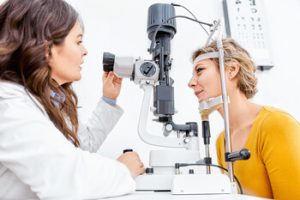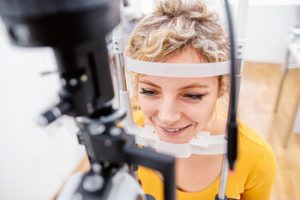Cataract vs Glaucoma — What’s the Difference Between the Two?
Both glaucoma and cataracts are typically familiar terms to most people. Keep reading to learn more about glaucoma and cataracts and the various treatment options for both of these common eye diseases.
Glaucoma and Cataracts: What’s the Difference?
Glaucoma and cataracts are two distinctly different eye diseases, though both can result in vision loss.
What is Glaucoma?
Glaucoma is a disease that involves optic nerve damage due to high intraocular pressure (eye pressure). The optic nerve is responsible for carrying neural signals from the retina of the eye to the brain.
 Damage to the optic nerve results from high intraocular pressure and leads to slow and progressive vision loss, usually beginning in the peripheral vision. In some cases, glaucoma can occur in the presence of normal intraocular pressure.
Damage to the optic nerve results from high intraocular pressure and leads to slow and progressive vision loss, usually beginning in the peripheral vision. In some cases, glaucoma can occur in the presence of normal intraocular pressure.
Eye pressure is determined by the balance of eye fluid drainage and production through the eye’s drainage system. If too much fluid, called aqueous humor, is produced in the eye but not drained at a balanced rate, the pressure will increase.
There are a few different classifications of glaucoma: open-angle glaucoma and angle closure glaucoma. This simply describes the state of the eye’s drainage system (opened or closed), but both states can result in fluid buildup.
Glaucoma symptoms
Typical symptoms of glaucoma can range from no noticeable symptoms to blurry vision, severe headaches, and seeing haloes around lights.
Early open-angle glaucoma tends to be associated with no noticeable symptoms as the eye pressure rise is often slow and subtle. With more advanced open-angle glaucoma, you will notice vision loss in your peripheral field. Late-stage glaucoma can also result in loss of your central vision. Conversely, acute angle closure glaucoma can present with blurred vision or seeing haloes, eye pain, nausea, severe headaches, vomiting, and a red eye. If glaucoma treatments aren’t initiated quickly, closed-angle glaucoma can result in extensive vision loss and blind spots.
What are Cataracts?
Cataracts are an opacity or haze of the eye lens, known as the crystalline lens. Though both glaucoma and cataracts are more likely with older age, unlike glaucoma, cataracts are typically considered normal. However, they can also be due to other causes, such as trauma, inflammation, or in association with other medical conditions.
Cataract Symptoms
Symptoms of a cataract tend to develop slowly. In the early to even moderate stages, you’re not likely to notice any change in your sight. However, as the cataract progresses, you may notice typical symptoms such as:
- Blurry or cloudy vision
- Poor night vision
- Difficulty seeing in low-contrast lighting
- Changes to your colour perception
- Frequent changes to your glasses prescription
Options to Treat Glaucoma
Several different glaucoma therapies exist, depending on your type of glaucoma and how well your eye pressure responds to treatment. All methods of treating glaucoma aim to lower the eye pressure to protect the optic nerve and prevent irreversible blindness.
Eye Drops
For the majority of patients with primary open-angle glaucoma, first-line treatment is medicated eye drops. These eye drops are designed to either reduce fluid production or increase fluid drainage.
Laser Treatment
A laser therapy known as selective laser trabeculoplasty may also be used to encourage fluid drainage from the eye during open-angle glaucoma.
For patients at risk of angle closure glaucoma, your eye doctor may recommend a preventative laser therapy known as a peripheral laser iridotomy.
Glaucoma Surgery
There are several different techniques when it comes to glaucoma surgery. These include:
- Minimally- or micro-invasive glaucoma surgeries (MIGS)
- Surgical procedures to insert a shunt or stent to drain fluid through the whites of the eyeball
- Glaucoma surgery to create a small drainage channel to the outside of the eye (trabeculectomy)
Cataract Surgery
 The only definitive cataract treatment is cataract surgery. However, this does not mean a cataract operation is necessary immediately at diagnosis.
The only definitive cataract treatment is cataract surgery. However, this does not mean a cataract operation is necessary immediately at diagnosis.
Your eye doctor will monitor you over time to assess how your cataracts affect your vision and daily activities. If you’re generally content with your vision, cataract surgery can be delayed. If your blurred vision becomes problematic, your doctor may then recommend cataract surgery.
Surgery involves the extraction of your cloudy crystalline lens and replacing it with a clear artificial lens. This is usually done under a local anaesthetic. Your surgeon creates small incisions through the front surface of the eye to insert the necessary instruments. After fragmenting the cataract, the pieces can be removed from the eye, and the artificial lens can be inserted in the place of the cloudy lens.
What if I Have Both Cataracts and Glaucoma? Combined Surgery
It is possible to have both glaucoma and cataracts at the same time, as the risks for either type of eye disease increase with age. If you need glaucoma surgery and you are also experiencing blurry vision from cataracts, your surgeon may recommend treating both your cataracts and glaucoma simultaneously.
Typically micro-invasive glaucoma surgeries are most suitable to be combined with surgery for cataracts. Often, the same incision used to remove the cataract can be used to perform glaucoma surgery.
Benefits of combined surgery for glaucoma and cataracts include:
- Being more convenient to attend to two procedures at one time instead of two separate operations
- Cheaper in cost compared to two separate procedures
- Can help to manage the potential eye pressure increase after a cataract operation by performing glaucoma surgery at the same time
In some cases of closed-angle glaucoma, removing the cataract alone is enough to lower the eye pressure as it allows the drainage system to widen and reduces the fluid buildup.
At other times, you may have glaucoma, but your cataracts are not causing any significant visual disturbance or impacting your glaucoma. In this case, your surgeon may not recommend cataract surgery at this time, but you will still need therapy for glaucoma, whether with glaucoma surgery, laser therapy, or eye drops.
Contact us now on (03) 9070 3580 for a consultation.
Note: Any surgical or invasive procedure carries risks. Before proceeding, you should seek a second opinion from an appropriately qualified health practitioner.
Reference
What’s the Difference Between Glaucoma and Cataracts?
https://www.healthline.com/health/glaucoma-vs-cataracts
Current Options for Surgical Treatment of Glaucoma
https://www.ncbi.nlm.nih.gov/pmc/articles/PMC5712968/#:~:text=Filtering%20surgery%20in%20glaucoma%20is,(IOP)%20then%20medical%20treatment.
Combined Cataract-Glaucoma Surgery
https://www.aao.org/eye-health/treatments/combined-cataract-glaucoma-surgery-facts#:~:text=These%20are%20called%20MIGS%2C%20or,uses%20to%20remove%20the%20cataract.






Leave a Reply
Want to join the discussion?Feel free to contribute!